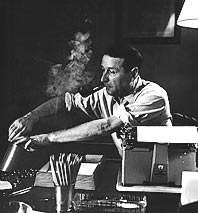
Georges Simenon (1903–1989) was the twentieth century’s Balzac. He wrote pulp by the ton before producing his serious works: the 70 or so Inspector Maigret novels, an ever-darkening franchise in which justice, of a rough and perverse sort, usually prevails, and the 100-some romans durs, or “hard novels,” he wrote between Maigrets, in which ordinary lives of quiet desperation suddenly jump the tracks.
No less gluttonous a researcher than Balzac, Simenon spent years wandering France by river and canal in small boats, and later, when Maigret made him rich, he roamed the planet gathering material. He soaked up regional physiognomies and accents, the prosaic details of trades and livelihoods, the distinguishing features of port cities and provincial towns—though he knew Paris and his native Belgium inside out, Simenon wanted a much bigger working map.
Simenon found convention suffocating yet necessary for the steady production of his novels. A devoted husband and father at home, he had a vast network of lowlife and criminal connections, countless affairs, and sex with thousands of prostitutes (also necessary for his production), with Mrs. Simenon’s blessing.
Balzac spares us nothing of what he’s learned (Witold Gombrowicz once compared him to an exquisite soup someone had squeezed a tablespoon of toothpaste into), but Simenon’s genius is the art of reduction. He can teach you how to run a restaurant in a few sentences scattered throughout a novel and how to poison your spouse with even fewer lines—in the same skinny book (Dimanche), no less.
Some of his characters turn into murderers, others dump their families and jobs and disappear to chase obsessions they didn’t know they had. A man or woman may simply break loose from a tedious existence, inhabit a new identity for a while, then return, changed or not, to the safety of former habits and routines. Simenon, who never outlined his plots in advance, generates continuous tension by keeping a novel’s several possible outcomes immanent until the last page or so. Like Patricia Highsmith, he grasped the psychopathology of the twentieth century at its intractable roots; the century started with alienation, and ended with alienation and sociopathy.
Simenon also practices a radical economy of language, using almost no adjectives or adverbs—his white space is more expressive than much of Hemingway and all of Raymond Carver. I suspect it’s because he didn’t fetishize the search for the perfect, startling word, a cause of literary acne that runs rampant in the work of writers like Cormac McCarthy and Annie Proulx. He thought the approximate word was quite good enough. Looking for the perfect one would have slowed him down.
NYRB, the publishing wing of The New York Review of Books, has been rescuing out-of-print literary marvels for several years, among them some of Simenon’s best non-Maigret novels: Three Bedrooms in Manhattan, Monsieur Monde Vanishes, Tropic Moon, Dirty Snow, and The Man Who Watched Trains Go By. The latest addition to this collection, Red Lights, takes us inside the head of a man “going into the tunnel” as he and his wife, Nancy, leave Long Island to pick up their kids at summer camp in Maine.
“The tunnel” is a place in Steve’s mind where Nancy’s better job, her occasional asperities, and his feelings of inferiority grow uglier as he bolts double whiskeys, to Nancy’s disgust, in bars along the traffic-clogged highway. It’s a typically shrewd Simenon touch that Steve isn’t an alcoholic, indeed hardly ever drinks heavily; moreover, he loves Nancy and their children. Yet his behavior en route becomes almost demonic. Nancy disappears while Steve visits another bar. He finds a note that says she’s going to catch a bus.
He gravitates to another saloon. A stranger rebuffs his attempts to start a conversation. When he leaves the place, Steve finds the same man sitting in his car. He’s escaped from prison—a jailbreak has been announced on the radio all evening, and Steve instantly understands who his new companion is.
The nightmarish traffic and lashing rain, the glaring sunlight on a gas station and a diner the next morning, the desuetude of the seaside town where the rest of the novel occurs—these shifting venues have such palpable reality on the page that Simenon makes a sagging porch emanate almost unbearable emotion. I know how he does it, but I have no idea how he can do it.
Among other things,Red Lights is one of the scariest literary renditions of how wrong things can go on too much alcohol—a sobering companion to Dostoyevsky’s “A Nasty Incident” and Hans Fallada’s The Drinker. It’s one of Simenon’s more tentatively hopeful novels as well.
A hopeful Simenon escorts you through hell before much hope comes into it (Three Bedrooms in Manhattan does for romantic love what this book does for drunk driving). But he isn’t interested in passing moral judgments, or interfering with his characters’ destinies, and he doesn’t mind if things occasionally come to a tolerably happy end.
Red Lights
By Georges Simenon. NYRB.